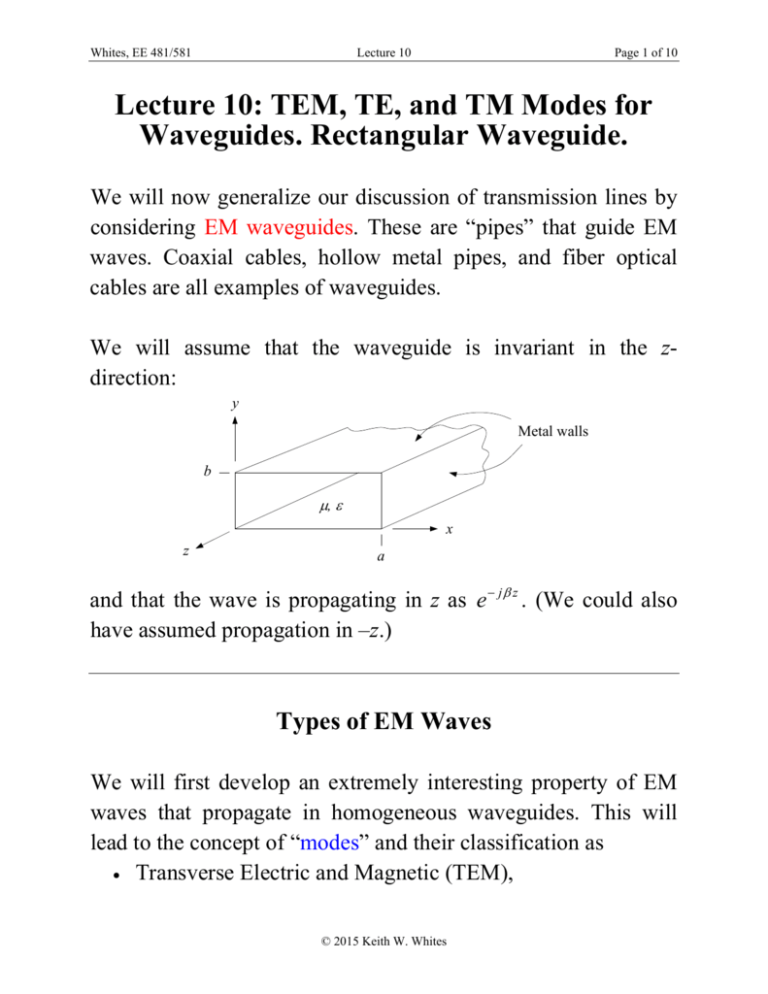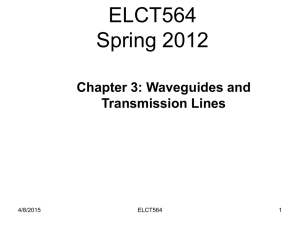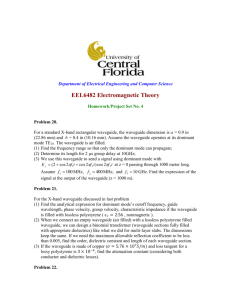Lecture 10: TEM, TE, and TM Modes for Waveguides. Rectangular
advertisement

Whites, EE 481/581 Lecture 10 Page 1 of 10 Lecture 10: TEM, TE, and TM Modes for Waveguides. Rectangular Waveguide. We will now generalize our discussion of transmission lines by considering EM waveguides. These are “pipes” that guide EM waves. Coaxial cables, hollow metal pipes, and fiber optical cables are all examples of waveguides. We will assume that the waveguide is invariant in the zdirection: y Metal walls b , x z a and that the wave is propagating in z as e j z . (We could also have assumed propagation in –z.) Types of EM Waves We will first develop an extremely interesting property of EM waves that propagate in homogeneous waveguides. This will lead to the concept of “modes” and their classification as Transverse Electric and Magnetic (TEM), © 2015 Keith W. Whites Whites, EE 481/581 Lecture 10 Page 2 of 10 Transverse Electric (TE), or Transverse Magnetic (TM). Proceeding from the Maxwell curl equations: xˆ yˆ zˆ E j H or x Ex y Ey j H z Ez Ez E y j H x y z E E ŷ : z x j H y z x E y Ex j H z ẑ : x y x̂ : However, the spatial variation in z is known so that e j z j e j z z Consequently, these curl equations simplify to Ez j E y j H x y E z j Ex j H y x E y Ex j H z x y (3.3a),(1) (3.3b),(2) (3.3c),(3) Whites, EE 481/581 Lecture 10 Page 3 of 10 We can perform a similar expansion of Ampère’s equation H j E to obtain H z j H y j Ex (3.4a),(4) y H z j H x j E y (3.4b),(5) x H y H x j Ez (3.5c),(6) x y Now, (1)-(6) can be manipulated to produce simple algebraic equations for the transverse (x and y) components of E and H . For example, from (1): j Ez Hx j E y y Substituting for Ey from (5) we find j Ez 1 H z Hx j j H x j y x j Ez j H z 2 2 Hx 2 y x or, Hx H z j Ez y x kc2 where kc2 k 2 2 and k 2 2 . Similarly, we can show that (3.5a),(7) (3.6) Whites, EE 481/581 Lecture 10 Hy H z j Ez x y kc2 Page 4 of 10 (3.5b),(8) Ex j Ez H z y kc2 x (3.5c),(9) Ey Ez H z j y x kc2 (3.5d),(10) Most important point: From (7)-(10), we can see that all transverse components of E and H can be determined from only the axial components Ez and H z . It is this fact that allows the mode designations TEM, TE, and TM. Furthermore, we can use superposition to reduce the complexity of the solution by considering each of these mode types separately, then adding the fields together at the end. TE Modes and Rectangular Waveguides A transverse electric (TE) wave has Ez 0 and H z 0 . Consequently, all E components are transverse to the direction of propagation. Hence, in (7)-(10) with Ez 0 , then all transverse components of E and H are known once we find a solution for only H z . Neat! Whites, EE 481/581 Lecture 10 Page 5 of 10 For a rectangular waveguide, the solutions for Ex , E y , H x , H y , and H z are obtained in Section 3.3 of the text. The solution and the solution process are interesting, but not needed in this course. What is found in that section is that m n a b 2 kc ,mn 2 m, n 0,1, ( m n 0) (11) Therefore, from (3.6) mn k 2 kc2,mn (12) These m and n indices indicate that only discrete solutions for the transverse wavenumber (kc) are allowed. Physically, this occurs because we’ve bounded the system in the x and y directions. (A vaguely similar situation occurs in atoms, leading to shell orbitals.) Notice something important. From (11), we find that m n 0 means that kc ,00 0 . In (7)-(10), this implies infinite field amplitudes, which is not a physical result. Consequently, the m n 0 TE (or TM) modes are not allowed. One exception might occur if Ez H z 0 (a transverse electric and magnetic, i.e., TEM, wave) since this leads to indeterminate forms in (7)-(10). However, it can be shown that inside hollow Whites, EE 481/581 Lecture 10 Page 6 of 10 metallic waveguides when both m n 0 and Ez H z 0 , then E H 0 . This means there is no TEM mode in these hollow metallic waveguides. Consequently, EM waves will propagate in hollow metallic waveguides only when the frequency is “large enough” since the TEM mode cannot exist. To understand this concept, consider (12) and using k 2 2 2 2 m n 2 2 2 (13) kc ,mn 11 a b If m n 0 is not allowed in the hollow metallic waveguide (i.e., no TEM mode), then must be “large enough” so that is a real number as required for a propagating mode. Otherwise will be imaginary ( j ), leading to pure attenuation and no propagation of the wave e j z e z . This turns out to be a general result. That is, for a hollow conductor waveguide, EM waves will propagate only when the frequency is large enough and exceeds some lower threshold. This minimum frequency for wave propagation is called the cutoff frequency f c ,mn . It can be shown that guided EM waves require at least two distinct conductors in order to support wave propagation all the way down to 0+ Hz. Whites, EE 481/581 Lecture 10 Page 7 of 10 The cutoff frequencies for TE modes in a rectangular waveguide are determined from (13) with 0 to be 2 2 m, n 0,1, m n f c ,mn (3.84),(14) ( m n 0) a b 2 In other words, these are the frequencies where mn 0 and wave propagation begins when the frequency slightly exceeds f c ,mn . 1 For an X-band rectangular waveguide, the cross-sectional dimensions are a = 2.286 cm and b = 1.016 cm. Using (14): TEm,n Mode Cutoff Frequencies m 1 2 0 1 n 0 0 1 1 fc,mn (GHz) 6.562 13.123 14.764 16.156 In the X-band region ( 8.2-12.5 GHz), only the TE10 mode can propagate in the waveguide regardless of how it is excited. (We’ll also see shortly that no TM modes will propagate either.) This is called single mode operation and is most often the preferred application for hollow waveguides. On the other hand, at 15.5 GHz any combination of the first three of these modes could exist and propagate inside a metal, Whites, EE 481/581 Lecture 10 Page 8 of 10 rectangular waveguide. Which combination actually exists will depend on how the waveguide is excited. Note that the TE11 mode (and all higher-ordered TE modes) could not propagate. (We’ll also see next that no TM modes will propagate at 15.5 GHz either.) TM Modes and Rectangular Waveguides Conversely to TE modes, transverse magnetic (TM) modes have H z 0 and Ez 0 . The expression for the cutoff frequencies of TM modes in a rectangular waveguide m n f c ,mn m, n 1, 2 2 a b is very similar to that for TE modes given in (14). 1 2 2 (15) It can be shown that if either m 0 or n 0 for TM modes, then E H 0 . This means that no TM modes with m 0 or n 0 are allowable in a rectangular waveguide. For an X-band waveguide from (15): Whites, EE 481/581 Lecture 10 Page 9 of 10 TMm,n Mode Cutoff Frequencies m 1 1 2 n 1 2 1 fc,mn (GHz) 16.156 30.248 19.753 Therefore, no TM modes can propagate in an X-band rectangular waveguide when f < 16.156 GHz. Dominant Mode Note that from 6.56 GHz f 13.12 GHz in the X-band rectangular waveguide, only the TE 10 mode can propagate. This mode is called the dominant mode of the waveguide. See Fig 3.9 in the text for plots of the electric and magnetic fields associated with this mode. TEM Mode The transverse electric and magnetic (TEM) modes are characterized by Ez 0 and H z 0 . Whites, EE 481/581 Lecture 10 Page 10 of 10 In order for this to occur, it can be shown from (3.4) and (3.5) that it is necessary for f c 0 . In other words, there is no cutoff frequency for waveguides that support TEM waves. Rectangular, circular, elliptical – actually, any shaped hollow, metallic waveguides – cannot support TEM waves. It can be shown that at least two separate conductors are required for TEM waves. Examples of waveguides that will allow TEM modes include coaxial cable, parallel plate waveguide, stripline, and microstrip. Microstrip is the type of microwave circuit interconnection that we will use in this course. This “waveguide” will support the “quasi-TEM” mode, which like regular TEM modes has no nonzero cutoff frequency. However, if the frequency is large enough, other modes (i.e., “higher-order” modes) will begin to propagate on a microstrip. This is usually not a desirable situation.








